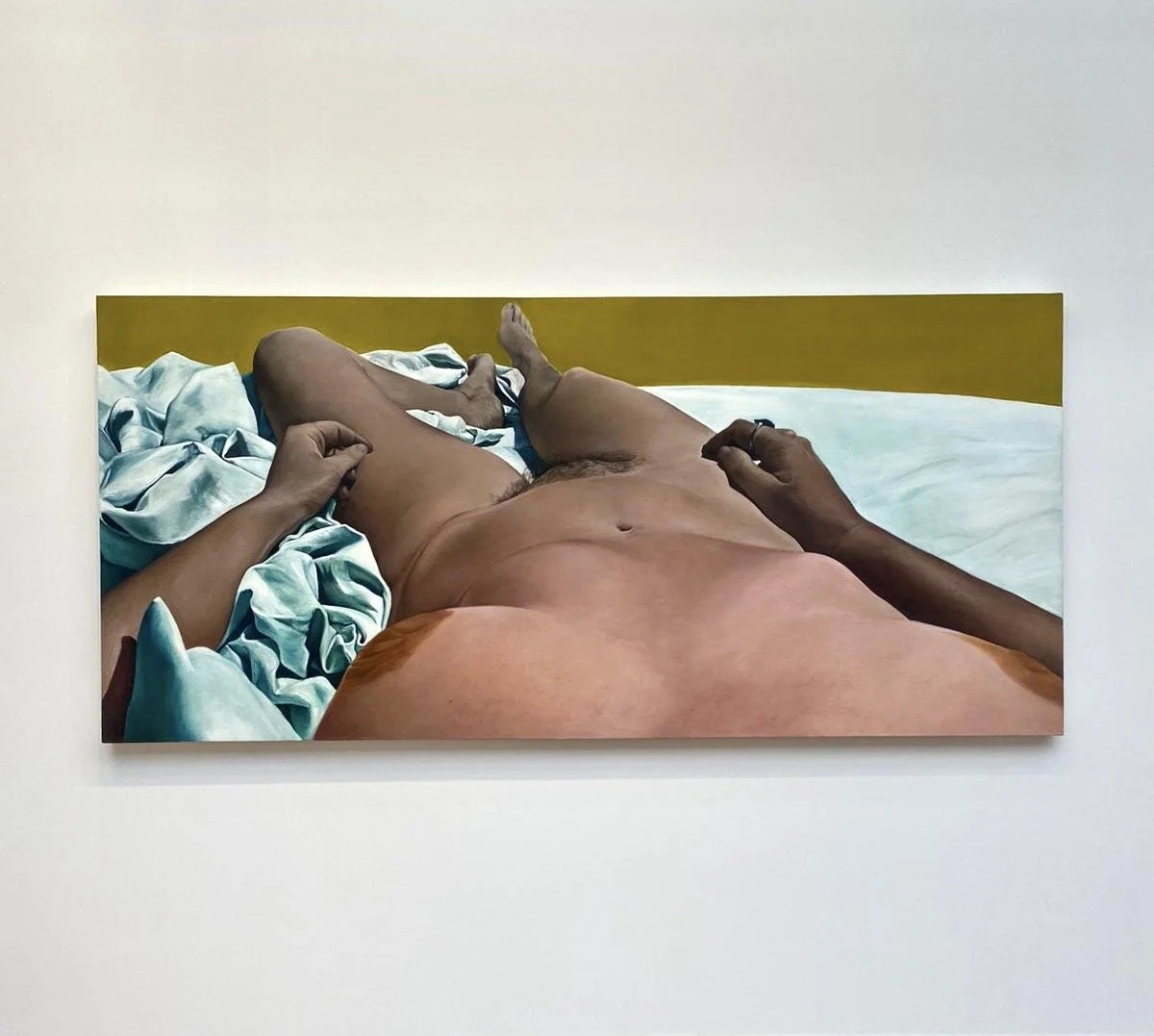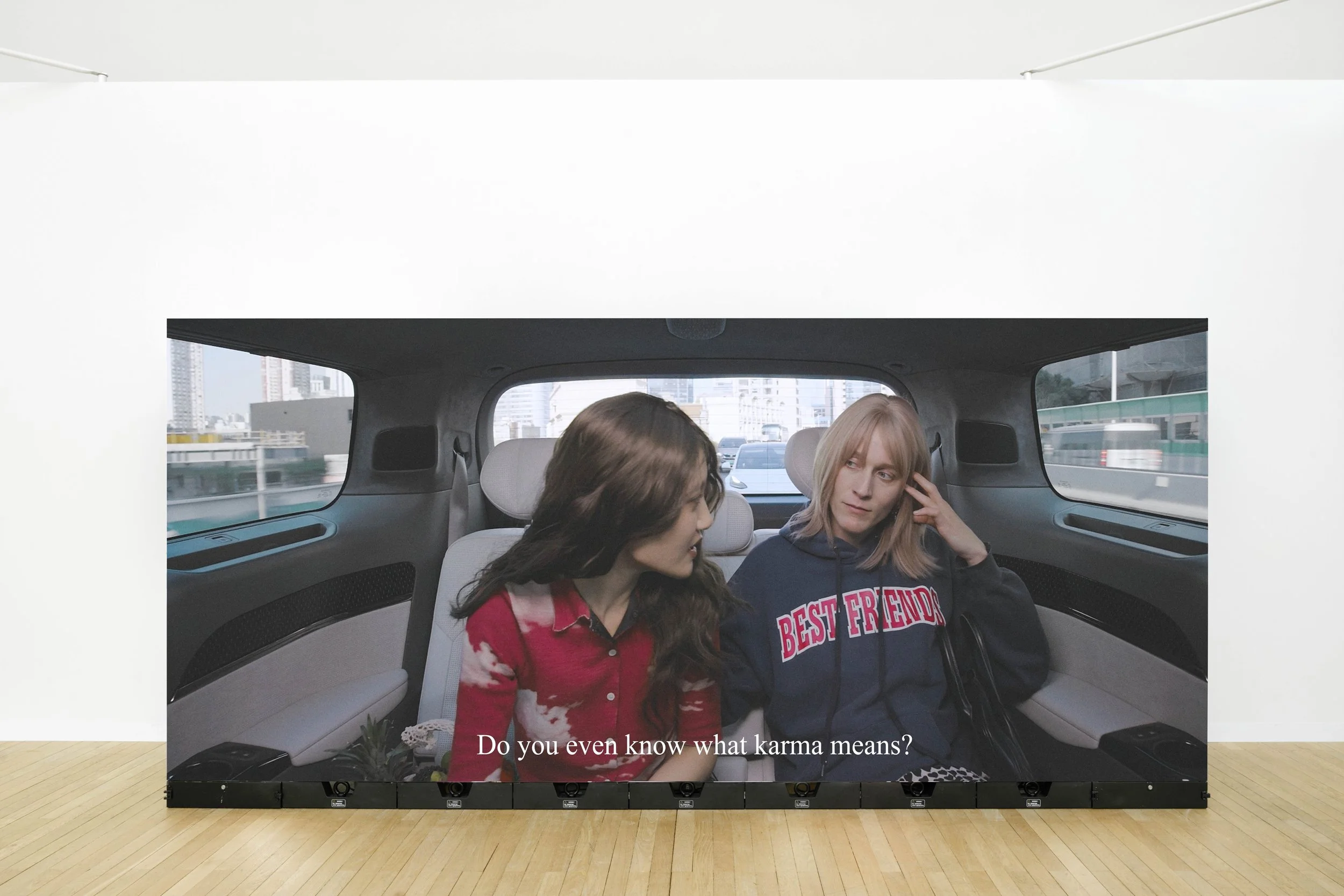Performing at Art Basel Paris
I am staring down a brunette bush at the Grand Palais in Paris. Joan Semmel’s large self-portrait Through the Object’s Eye (1975), displayed centrally in Ortuzar Projects’ stall at Art Basel Paris, depicts the artist’s naked physique in bed before a muted citrine backdrop.
The body is visible yet the face is unseen, lying just outside of the picture plane. This cropping substitutes Semmel’s countenance with the viewer’s frame of reference, which becomes one with the artist’s body. Her anatomy is relaxed, nestled into baby blue bedding, and flesh is rendered animate yet still through the softness of its tonality and its surrounding nondescript interior. Who is the subject creating the work, and who is the object? The line is intentionally blurred. Viewers, situated as Semmel herself, inhabit the depicted nude body as their own, not as something external to consume. The heterosexual male perspective that has capsized much of Western portraiture crumbles away into something far more tender and particular.
Semmel embraces self-definition to visualize a feminist interiority, actualizing her own autonomy within the space of the bed. The picture plane is the means by which she can grant others an experience both with her body and as her body. The image is erotic, not due to its sexualization of the female form but rather due to the circumstances of the viewer’s encounter with it. Intimacy is achieved through the elision of self and other, through the touching of these polemics.
Semmel’s painting strikes me as a radical stance for the broader context in which it is shown. Like any art fair, Art Basel Paris is a somewhat jarring cacophony of sights and sounds, characters and personas, objects and commodities. Meaning does not easily blossom in such an ecosystem.
If the museum is a mausoleum, then Art Basel is something of a slaughterhouse. Works of art are categorized by price and type and geographic origin to be housed in rows of uniform white cubes. These spaces are largely identical and feel medical in their sterility, which reinforces the line between art and non-art through the demarcated containment of the former. You are here, and the work of art sits there, external to you and awaiting your consumption. While this method of presentation is certainly useful for financial exchange, the express purpose of Art Basel, it also eliminates the beautiful mess of artistry. The marketplace undeniably enables a massive proliferation of artwork—as reflected by the seemingly infinite horizon of works in the Grand Palais—yet I wonder what forms and genres cannot come to light as a result of this economic structure.
What creative voices will we never get to hear due to the tethering of visual expression with wealth? For all the aesthetic futures that the art market generates, it simultaneously forecloses many others.
A manifesto by Maurizio Cattelan, BEING AN ARTIST IS NOT A JOB, IT’S A MALFUNCTION (2025), greets visitors to the fair due to its placement on the exterior of Perrotin’s stall, right by the entrance. Amongst a litany of provocative statements regarding the creative act and its broader role in society, Cattelan proclaims: “If you can live without it, it wasn’t art.” Contrary to Cattelan’s proposition, I believe that we actually can live without just about everything in the Grand Palais. This is not to say visual art serves no purpose—aesthetic practice does carry significant ramifications for culture, politics, and technology.
However, I am not certain that the particular flavor of visual art represented by Art Basel holds a fundamental significance to life itself. The entire fair is an exercise in excess; its purpose is to give elite clientele an aesthetically-pleasing place to invest an abundance of wealth. Anyone who has a spare $100,000 or $1,000,000 to spend on art does not, in fact, need it to survive.
While there are countless creatives that do rely on their studio practice to eat and to pay rent, Art Basel does not give voice to these figures. Rather, the artist is largely absent, relegated to a name on the wall, while the consumer and bourgeois interior remain the prevailing center of this world. This is why I am enamored by Semmel’s self-portrait; it reaffirms the essential agency of the artist as producer. Through her feminist articulation of the female nude, Semmel calls attention to the artist’s body as the generative force behind public pictorial spectacle. Her labor and subjectivity take the stage, challenging the consumer-oriented structure of Art Basel.
Siyi Li’s work New Energy (2025), on view in Cibrián’s stall, explores similar relationships between femininity, spectacle, and self-definition. The work follows the companionship of two young women as seen in vignettes of their taxi rides together throughout Shanghai’s sprawling cityscape. The dressing up of the two characters is a guiding element of the work. With each new car ride, the two women take up entirely new identities, adorning wigs of various texture and color, as well as garments for a range of occasions.
Alongside the costume changes, the two women share a complicated, ever-changing dynamic. At one moment, they are drunk partygoers returning from a rave, deciding what and where to eat. In another, they are international businesswomen striking up brand deals between Korea and Europe. The journey is long, never-ending, and cyclical; just before the two women seem to finally arrive at a destination, the airport, the credits roll, and the film quickly starts up again, back in the car.
In this tale of constant movement and fluid identity, the only stasis point is the palpable bond between these two women. Their relationship is spiritual in nature: they find each other in every iteration of themselves, sticking together through both the ebb and flow of the road and their connection. The soul continues to find a soft place to land amidst the ceaseless motion and constant self-reinvention required by contemporary urban life.
The work’s physical format, a massive LED screen placed in the middle of Cibrián’s white box, amplifies its spiritual qualities. The installation is large and bathes viewers in crisp white light. The effect feels like a technological parallel to stained glass or a hug from a Times Square billboard. I enjoy watching the video without headphones, reading subtitles as they trail along the screen and listening to the sea of chattering Art Basel patrons around me.
Immersed in the static noise of the public and the vibrancy of the screen, I resonate with the new energy that Li harnesses. His work describes a commitment to one’s enduring self and community even through the perpetual branding, rebranding, and performance required to make a living as a creative. The video thus provides a useful tactic for navigating spaces like Art Basel as a young artist.
Keep it moving, don’t get tied down into a singular version of yourself, and stick to those who see you for all that you are.
Art Basel Paris 2025 was held at the Grand Palais from October 23 through 26, 2025.



